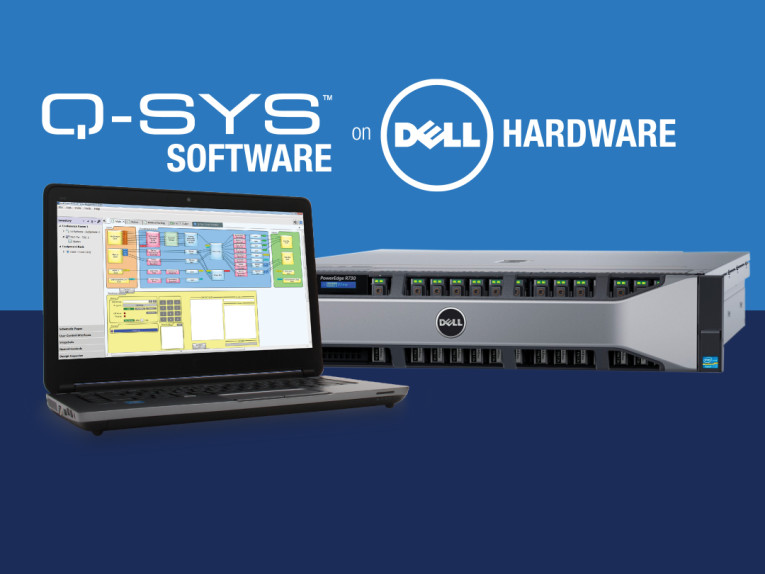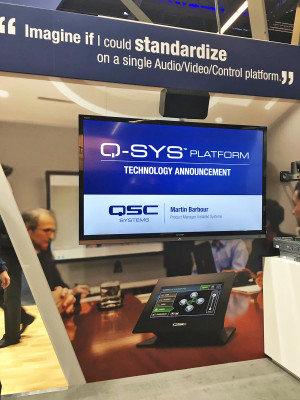
The technology demonstration at ISE 2017, in Amsterdam, was running existing 4th generation Q-SYS software on a high-performance standard Dell EMC PowerEdge R730 server. "This industry-first demonstration provides a glimpse into the future of the market where larger installations use centralized data center processing," said the company.
The Q-SYS Platform is centered on audio, video and control (AVC) solutions that take advantage of existing IT hardware, protocols and standards. The Q-SYS Platform uses standard Intel processing, Linux operating system services and IEEE networking protocols. "The technology demonstrated at ISE is the next evolution of this design paradigm, decoupling existing Q-SYS software from proprietary hardware and creating an architecture where centralized AVC processing can live in the data center. Now processing intensive features such as AEC and feedback suppression can become a shared resource for any meeting room across the enterprise. This, combined with a portfolio of cost-effective meeting room I/O peripherals, allows users to reliably distribute content and control using existing IT network infrastructure," they added.
Moving to standard mainstream server hardware reflects a typical enterprise IT environment and provides several benefits, particularly for corporate environments and global enterprises, including the possibility to follow established server deployment, maintenance and management best practices, as well as centralized resourcing with easier room resource moves, adds and changes, and automating on-demand deployment of DSP-intensive features such as AEC.
QSC also highlights the increased flexibility of this IT-based approach, allowing more effective support of centralized, distributed or hybrid system configurations, and enabling current and future software and service deployment models. Another factor, according to QSC is the reliability of the installation, allowing redundant power supplies, networking, storage, and processing as well as standard Dell BIOS level features including Dell Remote Access Controller (DRAC).

“The shift from dedicated hardware to centrally deployed software solutions for video, audio, and control systems makes perfect sense,” explains Saar Litman senior analyst at Wainhouse Research. “Today’s AV managers work within the IT department, and they expect solutions that behave like IT solutions in terms of scalability, extensibility, manageability, and integration with existing IT tools. The technology demonstration by QSC at ISE is directly in line with this migration from hardware to software.”
“We expect these kinds of systems to become the norm for corporate and larger scale enterprise installations in the future,” says TJ Adams, Director of Installed Systems Product Management at QSC. “By running the existing field-hardened Q-SYS software on a standard Dell EMC server, users have full backwards compatibility and can expand capabilities of their system by merely adding flexible and inexpensive I/O meeting room end points, such as the recently announced I/O-8 Flex Channel Expander. If localized processing is required in the meeting room, our range of medium-sized to smaller Unified and Integrated Cores, including the new Q-SYS Core 510i processor, fit seamlessly into the design.”
 “Furthermore, we work hard to leverage existing, widely accepted technologies when it makes the most sense, such as using Linux as the basis for our Q-SYS software stack, in effect creating an AVC Real-time Operating System (RTOS),” continues Adams. “Our partnership with Dell is the latest example of this philosophy. They are experts in designing, manufacturing and supporting enterprise-grade servers globally, and QSC looks forward to benefiting from their expertise. Our partnership allows the Q-SYS software development team to do what it does best – push the boundaries of audio, video and control innovation at the software level to meet the evolving needs of our partners and customers.”
“Furthermore, we work hard to leverage existing, widely accepted technologies when it makes the most sense, such as using Linux as the basis for our Q-SYS software stack, in effect creating an AVC Real-time Operating System (RTOS),” continues Adams. “Our partnership with Dell is the latest example of this philosophy. They are experts in designing, manufacturing and supporting enterprise-grade servers globally, and QSC looks forward to benefiting from their expertise. Our partnership allows the Q-SYS software development team to do what it does best – push the boundaries of audio, video and control innovation at the software level to meet the evolving needs of our partners and customers.”Per recent product announcements, QSC will continue to expand the Q-SYS Platform to provide standards-based in-room solutions that are highly flexible and simple to deploy and manage; including PTZ-IP conference cameras, lower channel count Core processors, I/O peripherals, bridges and streaming hardware.
“As AV and IT departments move toward a unified IT-centric organization, managers are being told that audio, video and control are now under their care and expect standardized enterprise-class platforms that cost effectively scale,” says Joe Pham, QSC's President and CEO. “By integrating a malleable software-based AVC platform with powerful Dell EMC standard servers, our technology demonstration at ISE highlights an inevitable shift in our industry to standards-based IT platforms. With the support of our valued server partner Dell EMC, this demonstration is yet another manifestation of ‘AV built for IT’, and I am proud to see QSC be the first to get there.”
Q-SYS Expansions
During ISE 2017, QSC also introduced the new Core 510i Integrated Core Processor. A first for QSC, the Core 510i processor can be configured as a full Q-SYS audio, video and control processing appliance or as an I/O peripheral that can accommodate any combination of Q-SYS analog, digital and networked audio I/O cards. The new processor leverages the latest Intel platform using a QSC-developed Linux realtime operating system (RTOS) and, according to the company, it offers the most flexible audio I/O configuration options of any processor in the Q-SYS catalog, with card-based I/O as well as native Q-LAN network channel and AES67 capabilities. It is ideal for applications that require a diverse mixture of analog, digital and networked audio connectivity, including mid- to large-sized meeting spaces and hospitality applications.

Unlike any other Q-SYS processor, the Core 510i can be deployed in two different software configurable modes. The Q-SYS Core mode handles all AVC processing including extensive resources for built-in acoustic echo cancellation (AEC) that can be deployed with the new Q-SYS AV-to-USB Bridging solution for soft codec conferencing applications. The I/O Frame mode allows support for up to 128x128 audio channels as an I/O peripheral into the Q-SYS system for processing on a separate Q-SYS Core processor. It can accommodate any combination of Q-SYS Type-II I/O cards including Dante, CobraNet, AVB or Q-SYS analog and AES/EBU cards.
Another new product introduced at ISE 2017 is the Q-SYS I/O-8 Flex Channel Expander, a compact, PoE+ capable networked peripheral offering cost-effective audio, control and USB extension to the Q-SYS Platform. Featuring eight flexible audio I/O channels, a QSC exclusive technology first seen on the award-winning Q-SYS Core 110f Processor, I/O-8 Flex allows users to easily configure each channel via Q-SYS Designer Software as either a fully balanced mic/line input with phantom power or a line level output. It also offers PoE+ support for simple, single-cable deployments plus an auxiliary DC power input that can be used for redundancy where required. With the same chassis and mounting solution as the QSC SPA Series power amplifiers, the I/O-8 Flex is ideal for mounting under the table in a conference room, on the wall or in a rack.

Acting as a Q-SYS peripheral, the I/O-8 Flex Channel Expander offers local Audio-to-USB bridging for integration with soft codec applications such as Skype for Business, GoToMeeting, etc. In addition, the onboard control connectivity including GPIO and RS232 can be used to provide Push-to-Talk or Push-to-Mute functionality and microphone LED status in addition to connectivity to any serially controlled device.
“We continue to focus product development efforts on solving real challenges integrators face day in and day out. The I/O-8 Flex provides integrators with a simple and cost-effective method for adding analog audio, control and USB audio I/O where they need it. All of this is achieved while using a single network cable, eliminating the need to pull a multitude of wiring around the facility,” said Martin Barbour, Product Manager for QSC Systems.

With the upcoming release of Q-SYS Designer Software v5.3, all Q-SYS Core processors shipped to date, including the Core 510i processor offer native AES67 capability without the need for any additional hardware or license costs. Support for the AES67 interoperability standard for audio-over-IP between various networking solutions allows high performance audio streaming between Q-SYS and third-party products supporting different native networked audio technology such as Dante, RAVENNA and Livewire without requiring any additional hardware or license costs.
www.qsc.com/systems






